Page 703 - My FlipBook
P. 703
FEVER. 713
that this equable temperature is disturbed, and that an elevation is
steadily progressing or is maintained above the normal, some factor has
entered into the economy from without, or has been produced by faulty
chemico-vital processes within, that has the effect of unbalancing the
combined functions of heat-production and heat-dissipation. This may
occur shortly after the receipt of an injury or the rise of an inflamma-
tion or of a complaint of languor, or seemingly as the result of the most
varied physical disturbances.
All of the features of the affection are arranged around this one cen-
tral phenomenon. The patient may or may not be conscious of the
increased heat. At the beginning of the rise of his temperature he
generally complains of chilly sensations. What is known as a chill or
rigor is coincident with a rise of temperature that is more or less sudden
or rapid, as is indicated by a thermometer under the tongue or in the
axilla. The sensations of the patient are not to be trusted, for while he
is shivering with cold his temperature may rise several degrees. After-
ward flashes of heat begin to alternate with the sensation of cold, and as
the case progresses the patient becomes ujipleasantly conscious of the
increased heat of his body. In the onset of certain forms of fever the
occurrence of chill is a prominent manifestation. This is especially
the case in what is known as chills and fever ; and indeed in all of the
types of malarial fever the duration and severity of the chill are espe-
cially marked, and the patient may be shivering with cold for an hour
or more, during which time he is unable to recognize the fact that he is
really unusually warm. The chill seems to mark a sudden rise of tem-
perature, but the gravity of the chill is not always in proportion to the
rapidity of the increase of heat. It has been suggested that the chill is
an illusory sensation brought about by the change in the temperature
relation of the body and the surrounding air ; but there is evidently
some other factor in the production of chill that is not yet certainly
made out.
In other than the malarial fevers there is much difference as to the
production of chill. Thus, in most of the grave inflammations of the
internal organs, such as occur in pneumonitis and other of the continued
fevers that are accompanied with distinct and severe inflammations, the
occurrence of chill at the onset is the rule, and the severity of the chill
usually bears some proportion to the severity of the attack. In inflam-
mations not primarily accompanied with fever a chill is very likely to
mark the beginning of the formation of pus or the development of an
abscess. It is generally not very severe, and the fever which results
usually passes away with the more complete formation of the abscess.
This seems to have some relation to the particular conditions at the seat
of the inflammatory process, in that the fever is called forth in the early
period of the inflammation or of the formation of pus, and ceases after
the effusion of plastic lymph has, so to speak, walled in the inflannna-
tory products by the closure of the lymphatics, by which absorption into
the general circulation is prevented or rendered less in amount. I will
speak of this again.
In surgical fever (fever following shock or accompanying the devel-
opment of inflammation in a wound) the chill is usually absent or but


